Audio Post Artistry: Creating Loop Group for HBO’s “Boardwalk Empire”
“You’ll never see a movie the same way again,” Dann Fink assures me.
A partner in New York City-based Loopers Unlimited, Fink doesn’t know how right he is. I’m about to embark on a very curious journey with him, an all-star audio team, an HBO producer, and eight handpicked actors. And when I come out the other side, I’ll understand an essential dimension of TV and movie sound that, up until today, I knew nothing about: loop group.
There’s plenty of hot coffee, muffins, bagels, and cream cheese at the ready for the crew this morning at Soundtrack, the multi-floor recording complex in NYC’s Flatiron district. Everybody’s going to need the nutrition, because today’s session is extra-special. On the agenda: record all of the loop group for the Season Four finale of HBO’s acclaimed series “Boardwalk Empire.”
A one-hour show with 58 total scenes, today’s episode is #48 and entitled “Farewell Daddy blues”, directed by Tim Van Patten, and the squad is going to have to move fast. There are 46 total cues to cover – so it’s a good thing that Fink and his companions are into this loop group thing.
The Soundtrack X-Factor
Virtually unnoticeable if handled correctly, “loop group” refers to the part of a film or TV show’s audio soundscape that must be created in post, providing crowd/ambient noises – as well as some ADR vocals – that are subtly essential to the reality of the scene.
Like every detail that is seen and heard on “Boardwalk Empire”, perfectly executed loop group is needed to execute the vision of the series’ highly esteemed creators. No less than the legendary Martin Scorcese, Terence Winter (“The Sopranos”), Mark Wahlberg (“Entourage”), Stephen Levinson (“In Treatment”), and Mr. Van Patten (“Game of Thrones”).
That explains why there’s a dream team of media professionals at Soundtrack’s Studio J today, all assembled to watch closely as the actors fastidiously chatter, laugh, cheer, gasp in horror, murmur indistinctively (“walla”), and also speak crisp lines of dialogue that – if mixed correctly – almost none of the shows millions of viewers will be able to clearly discern.
Fink and his invited thespians are joined by veteran post producer Brad Carpenter (“Bored to Death”), Emmy Award-winning Supervising Sound Editor Fred Rosenberg, Emmy Award-winning ADR Mixer Mark DeSimone (The Hunger Games, “Breaking Bad”) and Assistant Engineer Ric Schnupp.
Fink, who runs Loopers Unlimited along with his longtime business partner Bruce Winant, was drawn into loop group after years of experience in the Broadway world. In the likely event that he meets somebody at a cocktail party who’s unfamiliar with loop group, he’s got an explanation at the ready.
“I’ll usually start by asking them if they know what Foley/SFX is – very often they do – and I say we do the same thing just with actors instead of sound effects, to recreate the sound backgrounds of the environment in a scene,” Fink says. “If we’re anywhere with people speaking, I tell them to be quiet and look and listen for a moment. I explain how all of the people we see making that sound in a film would have been background actors who were being silent, and why. So someone like me works with the editorial and directorial team to figure out how to create or recreate the organic sounds of that scene and moment. Once in a while I’ll demonstrate by picking someone across the room and ‘looping’ him. People catch on fairly quickly and are usually very intrigued.
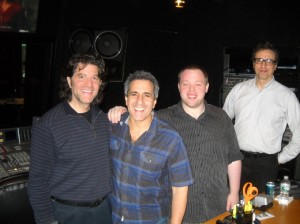
Shaping the “Boardwalk Empire” loop group, in the Soundtrack control room: (l-r) Mark DeSimone, Dann Fink, Ric Schnupp, and Fred Rosenberg.
“I’ve heard a few explanations for why the practice is called loop group,” Fink continues, “and the one that seems the most logical to me is that in the early days of what we now call ADR (automated dialog replacement), actors performed dialogue replacement by speaking their lines in sync to repeating loops of the image that were matched with strips of recording tape, that looped over and over. Hence ‘Looping.’ Loop group just specifies that versus principal ADR.”
Proprietors of loop group have a harder time finding heroes then many of the other verticals in TV and film production, since one hallmark of excellent looping is that it’s undiscernable. When pressed, however, Fink notes the work done on the Harry Potter film series as exemplary in its sonic effectiveness.
“When a team uses loop group as a textural element for the storytelling, as organically and delicately as they do Foley – to illuminate a moment, underscore an energy or heighten an emotion – that’s inspirational,” he states. “As a group leader, the payoff is when I get to let the actors dig into their years of craft and training, and they turn in performances that blow my mind. Happens all the time.”
In Session
Now in its fourth season, “Boardwalk Empire” – which stars Steve Buscemi as a corrupt political kingpin in prohibition-era Atlantic City – is a certifiable hit. The series has 40 primetime Emmy award nominations to its credit with 17 wins, and not surprisingly HBO recently renewed “Boardwalk” for a fifth season.
Today’s episode, “Farewell Daddy Blues,” is going to send Season Four off with plenty of excitement, and Fink – who spotted the episode with the production team weeks before at Brooklyn’s Steiner Studios where the show gets shot – is sufficiently motivated.
“This episode is as big as any Scorcese feature,” Fink says. “You’re going to see us in high gear, being every imaginable type of person: everyone from patrons and employees of an Atlantic City nightclub not unlike the Cotton Club, to a packed courtroom, all the way down to residents of a backwater bar in Tampa in 1924.”
Fink ushers a group of actors into the spacious, high-ceilinged live room of Studio J, where Rosenberg is already set up at a computer workstation and ready to monitor the action. With over three decades of TV and film audio experience, Rosenberg has acted as a sound editor, dialogue editor, ADR editor, or supervising sound editor. His reel includes When the Levees Broke, The Aviator, Eternal Sunshine of the Spotless Mind, Gangs of New York, Shaft (2000), O Brother, Where Art Thou?, The Ice Storm, Fargo, The Silence of the Lambs, “The Equalizer”, and dozens more.
As supervising sound editor for “Boardwalk Empire,” Rosenberg’s role is to oversee all aspects of the show’s postproduction sound except for the music. “I’m kind of the interface between the producers, the editors, and the mixer of the show,” says Rosenberg, who’s as colorful a character as any of the actors in the room. “I interpret what they ask for, and work with our sound editors as we try to realize what the filmmakers want to do.
“Loop group is important because there are places where you need human voices to sell the illusion. The unique thing about ‘Boardwalk’ is that there is a certain amount of humor behind it – that can come into play when we’re creating different textures.”
That levity is obvious right away when the session gets underway. Fink is half-camp counselor, half-cheerleader as he prepares his group of actors – a racially diverse, young-to-middle-aged ensemble of four men and four women — for the long day ahead.
“I make this disclaimer every time,” he reminds the upbeat group, “we all need to be a whole bunch of different people here – different races and ages! If what you do is not a match to the visual that I see, no ego if we have you sit back down – we all know that. Remember, jargon and stuff like that is OK in teeny little pieces, but everyone should pretty much speak in the English that we speak every day.”
Inside the Studio
In advance of the group’s arrival, DeSimone has gotten the Studio J live room ready. In front of the large video projection screen that will display the scene, DeSimone has two mics set up high overhead.
“I use a Sennheiser 416 boom for specifics such as an actor recording a solo person,” he explains. “That mic will be standard ADR setup, about three or four feet away and a few feet high, pointed to the bridge of the nose. For the group, I have a Sennheiser MKH 50 for mono recording that is farther away and higher up in the air.”
With DeSimone at the ready on the SSL 9000 J and Schnupp running Pro Tools, the mics go live, and the cues get underway. For a scene set in a Washington, DC government building, a very human kind of background noise is needed as two primary characters walk down a hall and have a conversation.
“We’re doing all the gibberish of the people in the offices that we don’t see,” Fink instructs the group. “Bad scatting is not acceptable. This is serious – it’s the FBI offices in Washington, DC. Not too busy. Okay? Great, everybody up.”
All eight actors step on to a large, approximately 8-foot x 8-foot square rug that roughly defines the congregating space in front of the microphones, and start milling around. Suddenly, a busy hum of nondescript conversation fills the room, an active melange of indistinctive syllables and consonants that would immediately inform the casual ear with certainty: a number of office workers are somewhere nearby, doing stuff.
Experienced up close and personal in the Soundtrack studio, it’s like hearing a Croatian conversation through wax paper and cotton. The experienced actors are making sure that no recognizable utterances emerge from the sonic texture. “It’s very subliminal,” Carpenter says to me, as we both watch the proceedings from the control room. “If a word pops up, it’s distracting. But as long as it’s gibberish, that’s okay.”
The two primary characters continue to move through the scene, and extras can be seen speaking to each other in the background. Like all onscreen interactions, I begin to realize that it becomes the loop group’s responsibility to account for these verbal exchanges.
Here, the session temporarily switches gears into a more standard ADR. Rosenberg has prepared a script for what he believes these background characters plausibly may be discussing. Since their lips aren’t clearly visible, it’s up to him to decide what was on their minds.
Fink invites one of the female actors to step up to the music stand below the mics, where he’s placed a script. “He lost the file… He’s kind of in a panic about it,” she says in a low voice, then moves on at Fink’s direction. Immediately, he motions for a male/female pair to take their turn at the mic. “Hello, Mr. Sims.” “Wonderful to meet you.” “We’re looking forward to making some progress.”
As multiple layers of dialogue, conversation and walla are built up, DeSimone mixes them on the fly so the loop group actors can hear the evolving landscape and work within it. Later on in the final mix that will be executed by Re-Recording Mixer Bob Chefalas at Soundtrack’s Studio K, the layers will be further refined – and shrink almost completely to inaudibility.
Advance Planning
Fink’s mission for each episode begins with the aforementioned spotting session. “I’ll give a big shout to the ‘Boardwalk’ team for having me on so early in the post process – it makes a huge difference on this show,” he says. “Spotting is a session where the creative team — often the entire creative team, but always the editorial and post team — sits together to dissect the needs of the episode. We watch sometimes scene by scene, or sometimes moment by moment, breaking down the settings, narrative and the demands of the sound environments.”
At that stage, much of Fink’s homework is done simply by listening to what the editorial team is talking through, and hearing their objectives. That’s when specific points that the writers, producers or editors have in mind come up, and Fink goes into microscopic mode.
“What exact age/ethnicity/voice/texture/energy do they want?” he says of the process. “Oh, a train – then what route do you think they’re on? Can I get a map of that from production? If there’s a big narrative event should we heighten it, comment on it or contrast it – things of that nature. Lots and lots of notes are taken, questions are asked, and our editors Tim Streeto and Kate Sanford are remarkable at filling us in on the artistic intentions behind scenes and moments and how the soundscape should function around or under it all.”
Once that phase wraps, Fink and Winant will pool their thoughts on a general casting breakdown, determining their needs for the group of actors or voices that might be perfect for that episode. Meanwhile, as casting is underway, Rosenberg creates a master cue sheet for general walla and specifics, along with a breakdown of any special material.
With the loop group cast set, Fink and Winant begin researching the precise locations and dates in the episode so that they have the right information at hand. Things that they’ll need at their fingertips on session day can be as specific as newspaper headlines from Chicago on the day of the Leopold & Loeb murder, general subjects like Atlantic City railroad routes or the differences in New York Penn station train announcements versus Atlantic City train, year to year. Writing templates for colorful boardwalk barkers also needs to be ready in advance.
Once all the actors are booked, the necessary evil of paperwork and union clearances must be chased down, copied, and prepped, all while the “Boardwalk Empire” post team keeps in touch with Fink and Winant about revisions, additions or requests – changes which can continue to arrive even mid-session.
“On this show,” Fink says, “the bar is extravagantly, wonderfully high and is run by a huge, extraordinary crew that is insanely passionate and dedicated to even the smallest aspects – and, they are tireless. We’re one of the elements that comes in late in the process so we have a short amount of time to accomplish what many get months for, but we strive to reflect the same passionate, extensive attention to details.”
Did I Get the Part?
Inside Studio J, things are about to get hectic.
A packed Onyx Club is going to turn from a place of revelry to a murder scene. If you can imagine the different ways a crowd will sound when they’re dancing and drinking, reacting to a gunshot, fleeing in a panic, feeling encouraged by the arrival of police, and passing judgment on the person that they haul off in handcuffs — you’re starting to get the idea of how busy this scene is going to be for the loop group.
The partying portion of the evening kicks off this series of cues, with Fink and Rosenberg both jumping up and into the fray. What happens next in the live room is truly amazing: the red “record” light illuminates, and it’s as if a switch has been thrown that instantly teleports a huge crowd into the space. Shutting my eyes and absorbing the commotion, it’s hard to believe that there are just eight people making all this racket.
The actors mill merrily around the space in front of the two microphones for minutes on end, combining and recombining constantly as they maintain their joyous energy. When Fink finally raises his hand to end the cue, everyone winds right down, and prepares to either do it again or move on.
“I’m trying to get performances that I think will sound believable,” Rosenberg notes. “So much of what does get performed and recorded is not usable – it sounds like someone is acting, or pretending. But within that there are these great nuggets of good stuff, and that’s what I’m looking for. It’s a very unnatural environment for an actor, and it’s kind of a testament to them that they’re able to give me those pieces.”
Once Fink and Winan have spotted and noted any specialties that they might need, they’ll review their entire roster to select the actors for a particular show. “Bruce and I put together every session as if we’re casting a play, and the group is always unique to the needs of the episode,” Fink says. “We begin by crafting a list of actors that fit the breakdowns, which on ‘Boardwalk’ can require an actor to be versatile enough to play multiple ages, ethnicities, dialects — and often within the same cue.
“Then like any casting process, we narrow down the actors, making sure we have a range of talents and textures, and we work like it’s an orchestra – putting together complementary voices with different sounds and physicalities that can solo well or blend seamlessly until we have the number that are most ideally suited for that episode’s breakdown. So many factors go into casting it’s impossible to encapsulate, and honestly it’s truly a mystery at its core. But we discuss a huge number of actors for every slot, and much sleep is sometimes lost over the choice of the right actor for the each track.”
According to Fink, there is no hard and fast answer to what makes the ideal loop group actor. However, he concedes that there are a few obvious necessities. “You have to have talent and a versatile instrument. You have to have solid craft. You have got to be directable and be able to commit to the dictates of the scene, even extreme ones. You have to be collaborative and generous.
“Then there’s things that we look for in our team of actors,” he continues. “We work as a team, so you have to be nice and be supportive of each other and the day’s goal. You have to be on time and walk in with research. Be serious about the work but don’t take yourself too seriously. We ask everyone to focus on the screen throughout the entire session since you never know how a cue someone else is doing might inform or impact the next cue or inspire, or teach you.
“You have to have no ego about the work. That comes naturally and easily to some, and others might struggle a bit until they find the sweet spot of being an individual, unique and yet part of the ‘Whole.’”
As Fink notes, the essence of the loop group’s job is to be invisible and become the foundation beneath the drama the principals create. As a result, his actors have to aspire to not be especially interesting – a mandate that flies in the face of their training.
“That might be the hardest thing of all for good actors,” he concedes. “But all in all, be willing, be a generous scene partner, and enjoy every second of what you’re doing because in the end, we’re being paid to do what we love. And how many people get to say that?”
It’s hard to imagine what actor especially wouldn’t enjoy the chance to engage in the particular loop group scenarios that “Boardwalk Empire” presents.
“Here’s a partial list of what we’ll do just for this show,” says Fink. “Selected keywords: corrupt politicians, gambling nuns, mobsters, rallies, showgirls, casinos, bootleggers of every nature, fancy showgirls, fancy naked showgirls, Faro card game dealers, whores, thugs, whores with thugs, congressmen and senators, congressmen and senators with whores and thugs, immigrants, FBI offices and officers, reporters uncovering corpses, people being killed in unimaginable ways, people killing people in unimaginable ways, people watching people being killed in unimaginable ways, alligator wrestling matches, hospitals but nothing too dramatic, people being blown up, people being gunned down, and as they were called then, ‘midget boxers.’ That’s actually could be one single episode. Not kidding.”
QC for the LG
No time for energy to lag, as the next sequence awaits. “It’s on to whores and johns!” Fink rallies the troupe.
Speed is important when a loop group leader is conducting a session, but quality control is paramount. “I listen to everything,” Fink says. “The first thing is to make sure the actor can physically produce a sound that the body onscreen would be making. Regardless of reality, unless we’re going for a comic effect, the voice has to sound organic to the onscreen actor’s physicality.
“Then it’s pitch, texture, energy, movement, scene context, and again, the mysterious creative who knows? An ‘oh’ can have a right and a wrong context for the response. And once in a while we don’t know what we’re looking for until we hear a voice on someone. That’s where the ego-less part comes in – we might pull you up and as soon as we hear your voice on the visuals, it doesn’t match and that happens to everyone at some point.
“But usually if you have cast the group right it works seamlessly, and sometimes we’ll cast people because of specific body types on screen. And if the actor is having fun ‘at play’ then they’re incredibly directable and nailing the cue will happen.”
Another quality that loopers are listening closely for from groups is vibrance and thickness of sound. “A group of people at a wake or in a police precinct can’t sound like they’re at a cocktail party. What dictates that a lot and what we’re sticklers for is content and context. The information in a line often leads an actor to how it needs to be delivered.
“Again that goes back to casting and direction. An actor with craft and a sense of play is gonna find that instinctively. That happens when a room is open and safe and an actor feels free to play, explore and challenge themselves.”
So when to redo a take? “I’ll use a metaphor here,” Fink says. “When you button your shirt one button off, and you don’t realize it but you know something isn’t fitting right? It’s that. Things fit or they don’t. There’s obvious things – the content or energy, someone uses a brand name, or the volume or density doesn’t sit right. That’s a go-back. Then there’s less obvious things and the entire room feels it.
“That’s another thing – the entire room,” he continues. “There of course needs to be people guiding everything, but this is an ensemble effort for us. We work together and every idea is welcome from anyone. On Boardwalk, Mark and Ric behind the board — and shout out to ADR Recordist Justine Baker, who fills in when Ric isn’t available — are indispensable for brainstorming and guidance.”
Time for the next cue: “Train station voices. English and gibberish.”
The Post Producer’s Perspective
In the control room, Carpenter is multitasking constantly while he keeps track of the proceedings. As the post producer for “Boardwalk Empire,” he is involved with editorial constantly, from the arrival of each day’s dailies through the final cut. He has careful notes from Winter and Van Patten, and he’s making sure that their intent is strictly adhered to.
“‘Boardwalk Empire’ is treated much more like a feature film — there are more sound editors on this show than others,” says Carpenter, a transplanted Midwesterner whose impressive career led from Iowa to LA to NYC. His portfolio has grown steadily in stature, post producing HBO’s “Bored to Death” and “Sex and the City,” as well as Showtime’s “Nurse Jackie.”
Carpenter describes the effect that loop group has on the production. “It goes back to creating a layer of reality,” he says. “You can’t draw the viewer in unless those layers are properly there. Sometimes you get specific and key information from it. It’s part of this supportive layer to the storytelling.
“’Subliminal’ is the best way to describe it. You wouldn’t want loop group to distract from the storyline. But if it’s not there, you realize in your brain that something is missing. You’re building a reality from the ground up — recording clean dialogue and building everything around it.
“Loop group is such an important layer, and it helps tell the story. On ‘Boardwalk’ in particular, loop group comes forward in very important ways: it helps you catch specific lines. It’s allowed to play a more significant role on this show, which I love.”
In the selection of Loopers Unlimited, “Boardwalk Empire” has a firm whose loop group and ADR credits include Gravity, The Secret Life of Walter Mitty, The Butler, “Nurse Jackie,” Limitless, Tower Heist, Extremely Loud & Incredibly Close, and Ice Age.
“Dann knows how to direct actors in a significant way,” Carpenter observes. “He brings in amazing actors to do loop group, and he has the creative instincts to interface with them. I never have to worry about who we are casting, or how they’ll be directed. All he asks is, ‘How many players can we have?’ He knows the loop group actors, and how many voices they can do. It’s like a little repertory company.
“As the sound supervisor, Fred is the one managing the whole thing. He’s coordinating all the mixers, and keeping track of all the various players: There’s sound effects editors, dialogue editors, and many more people on a very talented audio team. All of those things are happening at (the Chelsea audio post facility) c5 sound, in preparation for the final mix.”
Rosenberg works closely with Dialog Editor Jeff Stern, Foley Editor Steve Visscher, FX Editor Ruy Garcia, and Utility Editors Bill Orrico and Roland Vajs on “Boardwalk Empire.” He echoes the others’ sentiment that subtlety is key for quality loop group, but also expands on that. “That comment goes equally well for every aspect of filmmaking: when you’re aware of the artifice, you’re doing it wrong,” he states, “Having said that, definitely there are points in loop group where something will bring attention to itself – that’s not necessarily bad, if it’s in service of entertainment!
“It’s worth pointing out that ‘Boardwalk Empire’, besides being aurally interesting, is pretty. I think every aspect of it is quite musical. It’s a beautiful-sounding show.”
Technical Specs
Soundtrack, with its two downtown locations, has long stood as a top choice for elite TV/film music production and post production. Their spacious and well-equipped Studio J has what a show on the level of “Boardwalk Empire” requires.
“We have to understand the space we’re coming into, and how best to use it and to move the actors within it,” Fink says. “Not just acoustically, but everything from group size to movement and motion comes into play, and there’s a lot of prep regarding how we’re going to structure certain cues to get the best performances in that particular space, and orchestrate the voices in that specific room.
“So I need to know what rooms do what well, and along with the editors and mixers, how to move the actors about in the physical space to enhance that.”
DeSimone confirms that teamwork is a big part of it, and – like many serious pros – puts people skills ahead of technical prowess. “Part of being an ADR mixer is personality and interaction with the talent, editors, producers, directors – you have to establish a relationship. I usually try to make a connection with the people I’m working with, because it will make the end product better. It will make the actors more relaxed if there’s some interaction, so they can put down their guard a little bit.
“Of course, you have to have the technical skill. Not only to record, but to be on the alert for quick changes as they happen. You’re really there to give the most help you can to the actor. We keep the sessions nice and loose and relaxed, but at the same time Dann and Bruce have a tremendous specificity and are very well-prepared. You can’t just wing it for ‘Boardwalk.’ Everything has a specific feel, while the preparations have to be specific and true to the time period.”
In addition to the aforementioned mono microphone recording setup, DeSimone has a very exacting technique to capture stereo passes for inside crowds. “I will use two mics that are about 9 or 10 feet high in front of the screen, pointed directly at each other about a foot apart. Those mics will be two Schoeps MK 41 Supercardioid capsules with on CMC6 bodies.
“That will allow the actors to move all around the room, and it is preferred to be facing a wall or sitting far away and never in the middle facing the mics. It gives a nice round feel and the room bounce doesn’t feel like it’s just an off-mic recording, but it sits in the mix nicely so you can play it low.”
DeSimone runs the mics through four Neve 1073 preamps and four Neve 33609 compressor on the way to his 72-channel SSL board. “I’m a big fan of Neve compressors and mic pres,” he says. “The 33609 is set at a 3:1 ratio, with the threshold floating a little bit – it could be -2 to +2 depending on where we’re going. It’s a pretty quick recovery of 100-200 milliseconds, no limiter, and just a little gain, about 4 dB.
“The mic pres are really the key. They have very good headroom — between those and the microphones we use, we do not distort – sometimes it will border on being crispy, and we will pull back or use a mic pad.”
Listen Closer
In the weeks following my time at Soundtrack’s Studio J, I see Dann Fink was right: I haven’t been watching TV or movies the same since that day.
When I’m absorbed in a great film now, I notice when I notice the loop group — and I’m starting to notice when I don’t. To be more fully immersed in a production, loop group attunement informs the experience further.
I’ve especially noticed that while watching “Boardwalk Empire,” and realizing how extra rich it’s soundscape is. It’s an attribute that permeates every moment of every episode, Fink points out.
“Without question – the identity of the show is the undeniable duo aesthetic of Terence Winter and Martin Scorcese, supported and illuminated by the incredible contributions of every other person on the show — and I mean everybody,” he says. “For us, Fred is the visionary leader for our world. Every episode is operatic in theme, scope and setting. Every week is like doing a two-hour feature.
“The fine line in doing these cues is to always perform from the gut and the core – and never fall into caricature. Yes it’s period and stylized, but it’s very, very real and we keep a keen eye and ear on that. The show has such a specific vibrance and personality that we’re always looking to enhance that. Other than ourselves, we look to Fred, Brad and Mark to steer that with us.”
No question, “Boardwalk Empire” is an extreme challenge. But the intricate construction of its loop group also proves that in every second of sound, there is a beautiful opportunity.
“Together we break it down piece by piece, sometimes actor by actor, and build it from the ground up,” says Dann Fink. “Just like in on-camera, sometimes a one-minute sequence can take an hour to build. But that way we build it right. And it takes every ear, every eye, every cue.”
– David Weiss is the Founder/Editor of SonicScoop, and co-author of the book Music Supervision: Selecting Music for Movies, TV, Games & New Media.
Please note: When you buy products through links on this page, we may earn an affiliate commission.







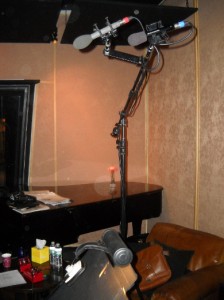
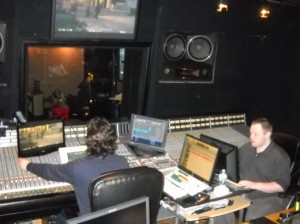
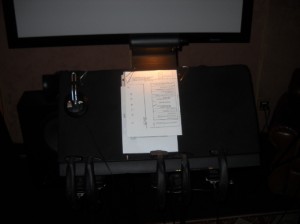
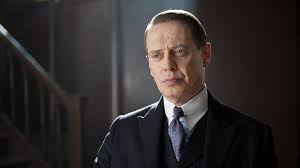

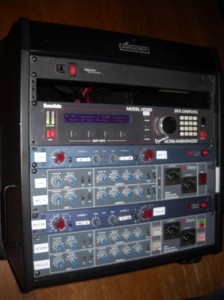
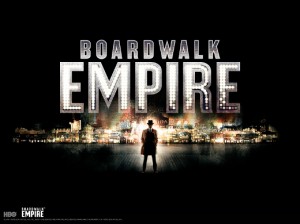
Deborah White
November 26, 2013 at 3:22 am (11 years ago)This article is really explains the looping process and the importance of a loop group leader, like Dann Fink, who comes to work with a total consciousness for the script, the images on the screen, the actors, the needs of the post supervisors, engineers, producers and the talent. Did I leave anything out? He didn’t. Great questions – great answers! Now I don’t have to stumble through efforts to explain what looping is. I will simply point any one with questions to this article. It’s really clear and concise. A good read, too!!!
Marz
December 5, 2013 at 10:27 pm (11 years ago)A pet peeve I am seeing far too often is misuse of then and than. Please do a refresher on your english skills. Yes, it does matter. Especially when it’s probably the only language you write and speak.
David Weiss
December 6, 2013 at 7:28 am (11 years ago)Hola Marz, yo hablo Espanol tambien, y tu?
Please let me know what particular sentence you are referring to so that we can make the appropriate correction. Gracias!